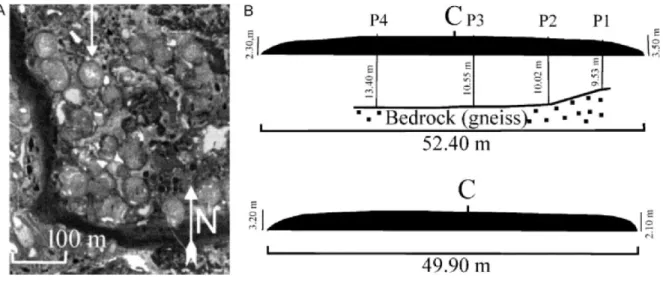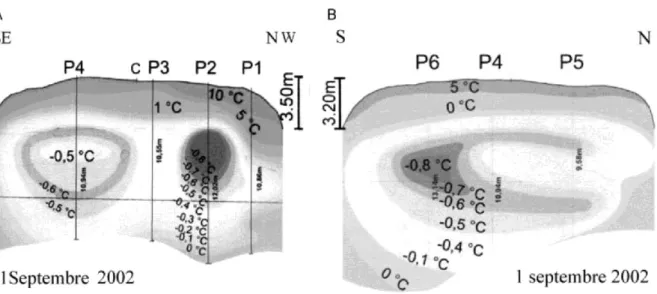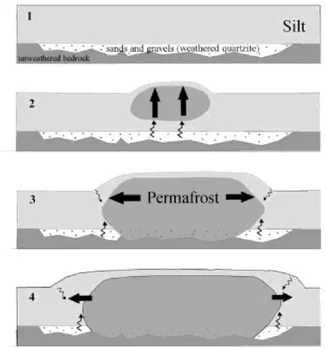The Side Growth of Lithalsas: Some Comments on
Observations in Northern Québec
A. Pissart
Department of Geography, University of Liège, Liège, Belgium
Correspondence to: A. Pissart, 29, Rue lavaux, 4130 Esneux, Belgium. E-mail: A.Pissart@ulg.ac.be
KEYWORDS: lithalsas; permafrost; ice segregation; frost thrusting; northern Québec; Hautes Fagnes
ABSTRACT
Based on observations in northern Québec and Belgium, the author infers that lithalsas in northern Québec are modern analogues of the enclosed and ramparted depressions that occur on the Hautes Fagnes plateau, Belgium. It is hypothesised that the growth of these lithalsas occurs not only by vertical heave associated with ice segregation within mineral material but also by lateral frost thrusting.
Introduction
Lithalsas and lithalsa remnants are relatively rare permafrost-related landforms. The best-known and most numerous lithalsas occur at present in northern Québec, Canada (e.g. Allard et al., 1996; Calmels, 2005; Calmels and Allard, 2008; Calmels et al., 2008a, 2008b). The majority are oval or circular in shape with a maximum height of less than 7 m (M. Allard, oral communication, 2002). Remnants of lithalsas from the end of the last glaciation have been described only in Belgium (Hautes Fagnes), Wales and Ireland (Pissart, 2000, 2003). The climate that prevailed in these three regions during the Younger Dryas was similar to the present-day climate in northern Québec.
Based on recent field observations made at a 3.5-m high lithalsa in northern Québec (Figure 1A), informally known as the BGR lithalsa (Calmels et al., 2005; Calmels et al., 2008a,b; Calmels and Allard, 2008), and the author’s own field experience on the Hautes Fagnes (Pissart, 2000, 2003), this short note speculates about the possible processes responsible for the growth of lithalsas. In particular, it focuses on the hypothesis that lithalsas may grow through lateral frost thrusting. Figure 1. Lithalsas in northern Québec. (A) Aerial photograph with the white arrow indicating the BGR lithalsa studied by Calmels (2005). (B) Perpendicular cross-sections, without any exaggeration, of elevations of the BGR lithalsa; the slopes on the surface of the lithalsa are gentle while the sides are steep. C: Centre of the mound; P1 — P4: boreholes. From Calmels (2005) and Camels et al. (2008a).
Recent observations from northern Québec
Drill cores extracted from the BGR lithalsa indicate that the volumetric ice content of the feature averages about 60 per cent, but volumes reach about 80 per cent at the top of permafrost (Calmels and Allard, 2008). This suggests the presence of aggradational ice (Allard et al., 1996) which means that the feature must have enlarged progressively through time. The oblique position of ice lenses at depth within the BGR lithalsa suggests that its growth may have occurred by lateral growth of the permafrost. Unfortunately, the orientation of the cores
table to 2.5 m, most of the ice lenses are horizontal and vertical joints and faults are not abundant. From 2.5 m downward, the lenses have high dip angles’. Because ice lenses develop parallel to the frost front, these observations suggest that the frost may have penetrated the lithalsa vertically near its upper surface but obliquely on the sides.
Calmels and Allard (2008) suggest how the inclination of the ice layers could originate from a freezing front that was either vertical or perpendicular to the uplifted lithalsa surface. However, these explanations are not completely satisfactory if the true shape of the lithalsa is considered (Figure 1B): it is 50 m in diameter and 3.5 m in height, with three-quarters of the difference in elevation relating to the outermost steep slopes. In other words, the shape of this lithalsa does not fit with the inferred process mechanism. This process would produce a dome-shaped mound rather than a flat-topped mound.
Discussion
Snow plays a major role in the evolution of lithalsas through its influence on the ground thermal regime. As soon as a mound grows upwards, its snow cover decreases and when the mound is fully formed, its surface may be blown clear of snow for all or part of the winter. Permafrost in the central part of the mound becomes colder due to the lower snow depths, but can expand at its sides towards the borders, because the active layer there is thicker and remains unfrozen longer due to thermal protection caused by snow accumulation. In this way, side growth can develop.
Calmels et al. (2008a, 2008b) measured temperatures within the BGR lithalsa (Figure 2) that illustrate two important points. First, much of the mound exhibits temperatures between −0.8°C and +1.0°C. This is the result of water seeping from the north into the ground towards the lithalsa; the N-S cross-section of the lithalsa (see Figure 9 of Calmels et al., 2008b) clearly shows this phenomenon and tritium analysis confirms its recent origin. If the ground temperature is less than, but close to 0°C, water may move through the mineral part of the lithalsa as capillary water. It will freeze to form segregated ice later when the temperature is lower. This releases latent heat giving rise to the ‘zero curtain’ effect that can be observed within the temperature data from within much of the lithalsa.
Second, the NW part of Figure 2A suggests lateral growth of the lithalsa. If the temperature declines from the lithalsa core outwards, the sloping contact between the permafrost and the active layer allows lateral frost thrusting (Washburn, 1979, p. 79). This is because aggradational ice would develop at the top of permafrost where it slopes (Figure 3). This idea is not new since frost thrusting was first suggested by Eakin (1916).
Figure 2. (A) NW-SE cross-section and (B) N-S cross-section showing temperatures within the BGR lithalsa on 1 September 2002 (Calmels, 2005, Fig. 4-8; b).s
Figure 3. The oblique upper limit of permafrost at the rim of BGR lithalsa based on temperature measurements made by Calmels (2005) and Calmels et al. (2008b), and the profile of the lithalsa. This suggests that the enlargement of lithalsas by frost thrusting is a possibility. The large arrow indicates the direction of growth.
The lateral frost-thrusting hypothesis explains the regular planiform shape of the lithalsas: the core of the lithalsa grows laterally and in doing so, thrusts aside the ice and, the frozen and the thawed material of the active layer. We believe that coarse material exists below the lithalsas as has been demonstrated for remnants of lithalsas in Belgium (Pissart, 2010) and because Calmels wrote, ‘... it exists a layer of coarse material in contact to bedrock. Its thickness may be variable...’ (personal communication, 2009). When the water in the coarse material below the lithalsas is frozen, vertical growth from below is impossible. Given the granulometry, segregation ice cannot develop as freeze-back takes place from the surface inwards (Figure 4, drawings 3 and 4). Segregation ice (aggradational ice) can develop only at the permafrost table beneath the sides of the lithalsas.
The side growth of lithalsas has not been observed directly. It is difficult to explain the very regular shape of so many lithalsas and the inclination of the ice layers within them without resorting to the lateral growth hypothesis. Consequently, it is inferred that the growth of the icy
thermal regime because it maintains higher temperatures within the lithalsa ramparts permitting their deformation. Based upon experience in the Hautes Fagnes (Pissart, 2010), weathered bedrock is indicated below the lithalsa and above the unaltered bedrock (Figure 4); it is this material that allows water to move freely towards the margins of the lithalsa and which permits the growth of aggradational ice.
Figure 4. Schematic diagram illustrating possible lateral growth of a lithalsa by frost thrusting and the formation of aggradational ice. The frozen sands and gravels of weathered bedrock are thought to prevent water flow from feeding the growth of segregation ice beneath the lithalsa. Wavy arrows: direction of water movement; thick arrow: direction of frost thrusting.
Perspective
Further observations are needed in order to determine how lithalsas grow and to estimate the importance of lateral enlargement. Unfortunately, carrying out these much needed observations directly would be difficult because current climatic warming is inducing the degradation of lithalsas rather than causing their growth. In contrast, it would be relatively easy to use a water pump to cut sections in existing lithalsas to examine the orientation of ice lenses within the mound which should conclusively demonstrate whether or not the lithalsas enlarged by lateral growth.
Acknowledgements
The author greatly appreciates the help of his friends Hugh French and Toni Lewkowicz who rewrote the present abridged version of a longer manuscript in response to the remarks of two anonymous referees.
References
Allard M, Caron S, Begin Y. 1996. Climatic and ecological controls on ice segregation and thermokarst: the case history of a permafrost plateau in Northern Quebec. Permafrost and Periglacial Processes 7: 207– 227.
Calmels F. 2005. Genèse et structure du pergélisol. Étude des formes périglaciaires de soulèvement au gel au Nunavik (Québec nordique), Canada. Thèse du doctorat, Université Laval, Québec, 169pp.
Calmels F, Allard M. 2008. Segregated ice structures in various heaved permafrost landforms through CT scan. Earth Surface Processes and Landforms 33: 209–225.
Calmels F, Allard M, Delisle G. 2008a. Development and decay of a lithalsa in Northern Québec: A geomorphological history. Geomorphology 97: 287–299.
Calmels F, Delisle G, Allard M. 2008b. Internal structure and the thermal and hydrological regime of a typical lithalsa: significance for permafrost growth and decay. Canadian Journal of Earth Sciences 45: 31–43.
Eakin, HM. 1916. The Yukon Koyukok Region. U.S. Geological Survey, Bulletin 631. 88pp.
Pissart A. 2000. The remnants of lithalsas of the Hautes Fagnes (Belgium): a summary of present day knowledge. Permafrost and Periglacial Processes 11: 327–355.
Pissart A. 2003. The remnants of Younger Dryas lithalsas on the Hautes Fagnes Plateau in Belgium and elsewhere in the world. Geomorphology 52: 5–38.
Pissart A. 2010. Remnants of lithalsas on the Hautes Fagnes plateau (Belgium) are on weathered quartzitic rocks. Zeitschrift für Geomorphologie 54: 1–15.
Washburn AL. 1979. Geocryology. A Survey of Periglacial Processes and Environments. Edward Arnold: London; 406pp.


